
Sometimes you’ve got to wonder what the boffins inside car companies are thinking, always saying one thing and then doing another.
In this instance, I’m talking about Ford, the US auto giant that – like many other companies – has for, at least the last 20 years or so, been banging on about global platforms, allowing it to produce and sell the same model vehicles all over the world. In fact, the company even has a name for its global platform ethos: ‘One Ford’.
But while Ford has several ‘global’ SUVs on its books, including the diminutive Ford Ecosport, the midsize Kuga (soon to be renamed Escape), the larger-again Edge, as well as the Aussie-engineered Ford Everest and Ranger models, all of which are built in both left- and right-hand drive, there is one significant omission: the current LHD-only Ford Explorer.
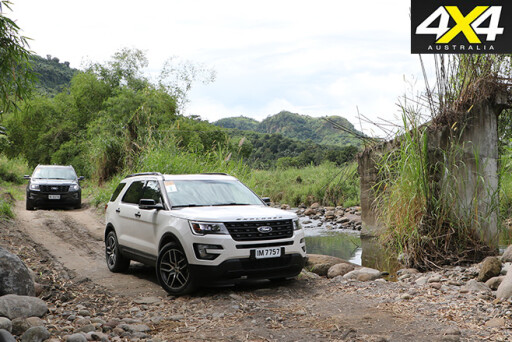 The close of Ford’s local manufacturing operations just a couple of months ago spelt the end for the popular Falcon-based Territory seven-seat wagon, and while Ford has said it will fill the void with its new Canadian-built Ford Edge, we wonder if the slightly larger seven-seat Explorer wagon would have better filled the gap.
The close of Ford’s local manufacturing operations just a couple of months ago spelt the end for the popular Falcon-based Territory seven-seat wagon, and while Ford has said it will fill the void with its new Canadian-built Ford Edge, we wonder if the slightly larger seven-seat Explorer wagon would have better filled the gap.
After all, at this stage the Canadian-built Edge is only available in a five-seat configuration; although, there is a Chinese-built seven-seat version of the Edge that is more closely matched to the local competition, which includes vehicles such as the Holden Captiva and Toyota Kluger.
Regardless, the Edge isn’t likely to land in Australia until about 12 months after Territory sales end in 2017, so it’ll be up to the Ranger-based Everest to fly the blue flag in this market segment until that time.
THE EXPLORER
The Edge is close to the outgoing Territory in terms of overall size. In fact, it has a slightly longer wheelbase, is wider and taller, albeit shorter, at least in five-seat guise.
Curiously, neither the five- nor seven-seat versions of the Edge were present on a recent drive in the Philippines that Ford had organised to show off its current SUV line-up.
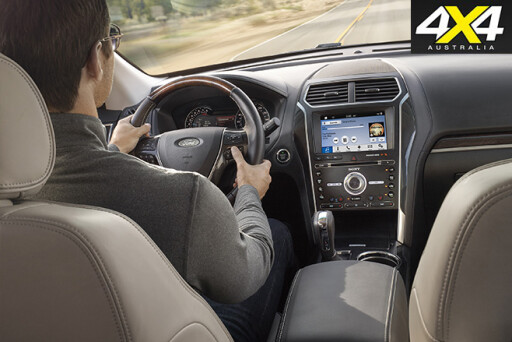 While there was no Edge, the Philippines drive program gave 4X4 Australia the opportunity to sample four of Ford’s six ‘E’ vehicles (see breakout below), one of which was the impressive North American-market Explorer, which we tested on both sealed and gravel roads, and we can tell you, it’s a bloody nice thing!
While there was no Edge, the Philippines drive program gave 4X4 Australia the opportunity to sample four of Ford’s six ‘E’ vehicles (see breakout below), one of which was the impressive North American-market Explorer, which we tested on both sealed and gravel roads, and we can tell you, it’s a bloody nice thing!
The Ford Taurus-based Explorer is bigger than the Territory – about 15cm longer, 10cm wider, 6cm taller and with 23mm more ground clearance – and it has a voluminous interior with clever seven-seat packaging. The model we sampled was the high-spec Explorer Sport equipped with Ford’s Optional Intelligent 4WD System with Terrain Management System.
In the US, the 4WD version of the Explorer (there’s also a 2WD version) comes in two spec levels: the Sport at US$45,355 and the top-spec Titanium at US$53,235. If there were a right-hand drive version, and if it were sold here, chances are it would be significantly more expensive than the outgoing Territory.
 Having said that, the Explorer is jam-packed with high-end equipment and electronic goodies, and is powered by Ford’s latest-generation twin-turbo Ecoboost V6 engine, which is an absolute pearler.
Having said that, the Explorer is jam-packed with high-end equipment and electronic goodies, and is powered by Ford’s latest-generation twin-turbo Ecoboost V6 engine, which is an absolute pearler.
THE DRIVE EXPERIENCE
The 3.5-litre turbocharged, direct-injection petrol V6 punches out claimed peaks of 365hp (272kW) at 5500rpm and 350ft/lb (475Nm) at 3500rpm, all while achieving a claimed combined fuel cycle of 13.1L/100km. That’s significantly better output than the outgoing six-cylinder petrol Territory (195kW/391Nm) in a vehicle that weighs around 100kg less.
It’s also better than any of the engines that will be offered in the Edge, which in various markets around the world include a 2.0L turbo-diesel four (154kW/450Nm), a 2.0L turbo-petrol four (136kW/373Nm), a 3.5L petrol V6 (208kW/339Nm) and a 2.7L turbo-petrol V6 (235kW/475Nm).
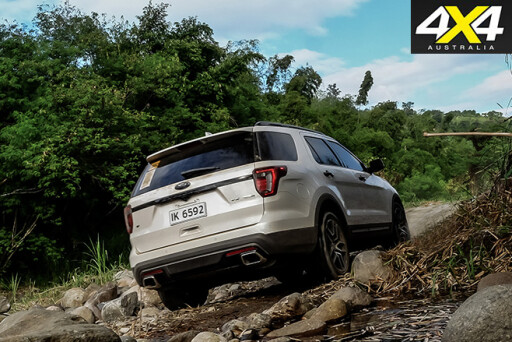 Put your boot into the Explorer and it gets up and boogies. The 3.5L Ecoboost V6 is mated to a smooth-shifting six-speed auto transmission that kicks down as fast as you’d want when you’re in a hurry. And as the tacho needle heads towards the red zone the engine just keeps on giving, all the while emitting a nice beefy note to perfectly accompany the impressive acceleration on offer.
Put your boot into the Explorer and it gets up and boogies. The 3.5L Ecoboost V6 is mated to a smooth-shifting six-speed auto transmission that kicks down as fast as you’d want when you’re in a hurry. And as the tacho needle heads towards the red zone the engine just keeps on giving, all the while emitting a nice beefy note to perfectly accompany the impressive acceleration on offer.
Sure, there’s no diesel engine option, which would likely have proved more popular in Australia than a big petrol six, but had the Explorer been a part of Ford’s ‘One Ford’ strategy…
Anyway, back to the drive experience. Unlike the last Explorer sold in Oz, this one has the ride and handling to match its performance. In fact, the suspension tune is surprisingly firm; not the wallowy set-up you might expect if you’d driven older-generation US-market SUVs.
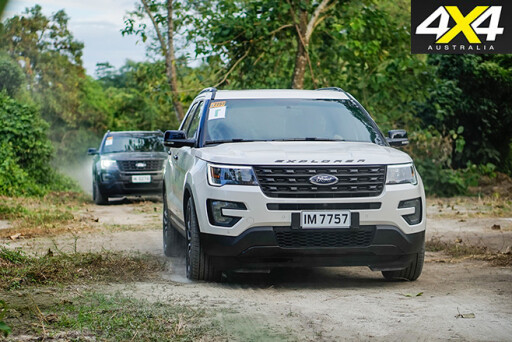 The roads in the Philippines are pretty crook, which showed how well the Explorer deals with big bumps and potholes, and it does so without exhibiting much of the booming noise you often get when driving big monocoque vehicles over rough surfaces. And the steering is surprisingly (again) direct and accurate; it’s not overly assisted and it offers good feedback. Oh, and plant your foot on the brake pedal and the Explorer pulls up quickly and tidily.
The roads in the Philippines are pretty crook, which showed how well the Explorer deals with big bumps and potholes, and it does so without exhibiting much of the booming noise you often get when driving big monocoque vehicles over rough surfaces. And the steering is surprisingly (again) direct and accurate; it’s not overly assisted and it offers good feedback. Oh, and plant your foot on the brake pedal and the Explorer pulls up quickly and tidily.
The gravel road loop was quite short, and it was all driven at relatively low speeds, and while it did offer the chance to play around with the Terrain Management System (TMS), it was quite difficult to pick a discernible difference between the four settings, which include Normal, Snow, Sand and Mud/Ruts.
The different TMS modes, which are accessed by a familiar rotary dial on the centre console, affect the transmission shift program, throttle response and stability control sensitivity. For example, in the Snow setting the transmission upshifts at lower engine revs to help prevent wheel spin, while in Sand it holds on to lower gears for longer to prevent bogging down.
 Despite a claimed 200mm of ground clearance, the Explorer will soon bottom out over rough terrain, and wheel travel is also quite limited, but like the Territory, off-road duties are not this vehicle’s core focus. It will, however, get riskier driver’s out of most slippery situations thanks to the TMS that automatically apportions torque between front and rear wheels as necessary. The Explorer is also equipped with Hill Descent Control, which is more valuable in a single-range SUV like the Explorer than a hardcore off-roader with decent low-range reduction.
Despite a claimed 200mm of ground clearance, the Explorer will soon bottom out over rough terrain, and wheel travel is also quite limited, but like the Territory, off-road duties are not this vehicle’s core focus. It will, however, get riskier driver’s out of most slippery situations thanks to the TMS that automatically apportions torque between front and rear wheels as necessary. The Explorer is also equipped with Hill Descent Control, which is more valuable in a single-range SUV like the Explorer than a hardcore off-roader with decent low-range reduction.
THE PACKAGING
As mentioned earlier, the interior of the Explorer offers loads of space. In fact, Ford claims a passenger volume of 2313L (behind the first row), which is significantly more than the Edge’s quoted volume of 2078L and the Everest’s quoted volume of 2010L, but it’s the interior packaging of the Explorer that’s most impressive.
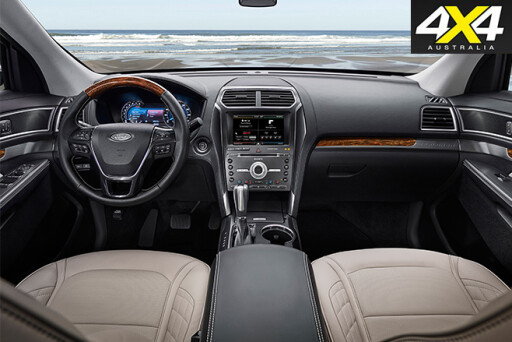 When you slide into the big yet supportive driver’s seat, you’re faced with an attractive dash with logically positioned controls and quality switchgear. In typical US fashion, the park brake is a foot-operated jobbie, but other than that the styling is very contemporary and it wouldn’t look out of place on a Euro-designed vehicle. The trim is of a very high standard and the double-stitched leather looks great. The electrically adjustable seat combines with electrically adjustable steering and pedals, so just about anyone can find the right driving position.
When you slide into the big yet supportive driver’s seat, you’re faced with an attractive dash with logically positioned controls and quality switchgear. In typical US fashion, the park brake is a foot-operated jobbie, but other than that the styling is very contemporary and it wouldn’t look out of place on a Euro-designed vehicle. The trim is of a very high standard and the double-stitched leather looks great. The electrically adjustable seat combines with electrically adjustable steering and pedals, so just about anyone can find the right driving position.
The second-row seat on our test vehicle offered a traditional 60:40 split and loads of legroom. In the US there are optional twin bucket seats for the second row that incorporate a large centre console with cup-holders. The power-operated third-row seats are the interior packaging’s pièce de résistance: they are controlled via four switches in the cargo area that allow you to set them up, stow them or fold them at the push of a button, either individually or together.
 When set up they offer ample space for a couple of kids, and when stowed they fold into the floor providing a flat load space all the way to the front seats, if you also fold away the second row.
When set up they offer ample space for a couple of kids, and when stowed they fold into the floor providing a flat load space all the way to the front seats, if you also fold away the second row.
xIf the outside styling looks somewhat familiar, it’s probably because the blacked-out A- and B-pillars give it a floating roof look similar to a Range Rover. Oh, that and the fact that the chief engineer on the Explorer (Jim Holland) also previously worked on the L322 Range Rover.
One thing that does stand out about the styling of the Explorer is that it doesn’t have the ‘One Ford’ look about it, which is part of the DNA of the Ecosport, Edge and Everest, as well as the upcoming Escape. Instead, the Explorer is all swoopy lines at the front and more distinct angled surfaces around the rest of the body, possibly aimed more specifically at North American tastes.
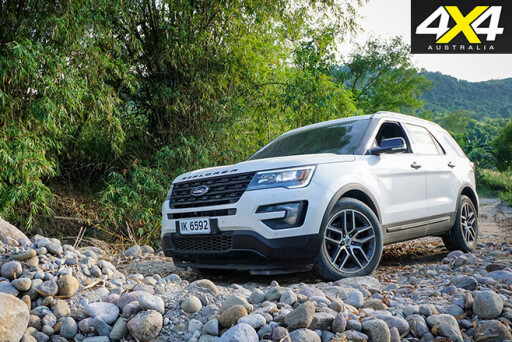 Nevertheless, the wide, low stance of the Explorer and its unique styling would likely find acceptance in Australia in a premium market niche, if ever a RHD version were built which, unfortunately, will probably never happen. So, ‘One Ford’ it is… except for North America… and China.
Nevertheless, the wide, low stance of the Explorer and its unique styling would likely find acceptance in Australia in a premium market niche, if ever a RHD version were built which, unfortunately, will probably never happen. So, ‘One Ford’ it is… except for North America… and China.
THE STOPGAP
With the potential for a 12-month gap between the end of Territory sales and the introduction of the Edge, and no Oz-bound Explorer, that leaves the Everest as Ford’s lone battler in the ever-growing seven-seat SUV category.
Despite the Everest being built on the Ranger ute platform, with separate-chassis and a live-axle rear-end, it still does a damn good job of impersonating the on-road performance of a car-based SUV.
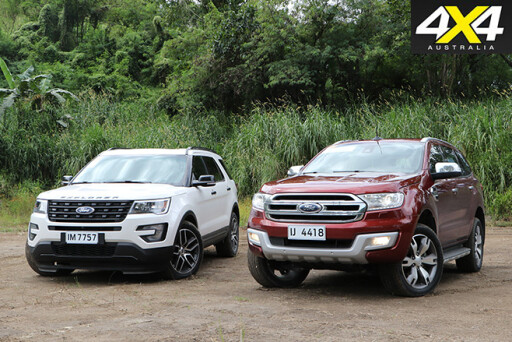 Its torque-laden 3.2L five-cylinder turbo-diesel engine (143kW/470Nm) endows it with more than adequate acceleration and ample towing capability, and it actually rides and handles surprisingly well considering its commercial heritage. Sure, it feels a bit cumbersome on the road when driven back-to-back with the Explorer, but take it off the road and it leaves the American SUV in its dust.
Its torque-laden 3.2L five-cylinder turbo-diesel engine (143kW/470Nm) endows it with more than adequate acceleration and ample towing capability, and it actually rides and handles surprisingly well considering its commercial heritage. Sure, it feels a bit cumbersome on the road when driven back-to-back with the Explorer, but take it off the road and it leaves the American SUV in its dust.
SPECS: Ford Explorer AWD
Engine: Twin-turbo, direct-injection V6
Capacity: 3.5-litre
Power: 272kW @ 5500rpm
Torque: 475Nm @ 1200-3200rpm
Gearbox: six-speed auto
4X4 System: On-demand, TMS
Construction: Monocoque
Front suspension: independent/MacPherson strut
Rear suspension: independent/multi-link
Wheel/tyre spec: alloy / 255/50R20 105H
Kerb Mass: 2020kg
GVM: N/A
Payload: N/A
Towing capacity: 750/2267kg
Seating capacity: 7
Fuel tank capacity: 70L
Combined fuel claim: 13.1/100km
On-test consumption: N/A
Touring range: N/A
Price From: US$45,355-53,235

COMMENTS